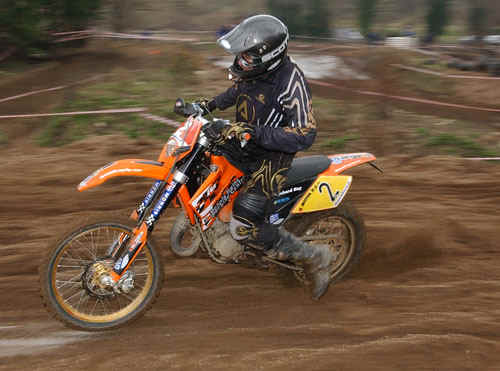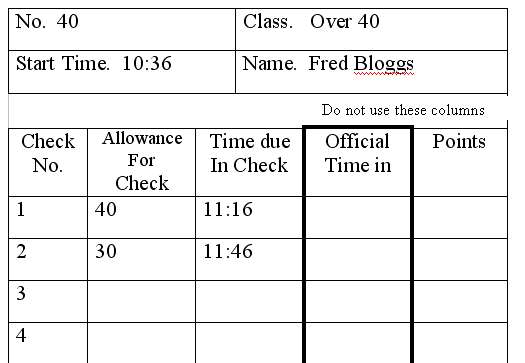Beginners Start Here
If you are new to the sport or are unsure of the rules etc - start here. And e-mail me with any queries if you are unsure. We want you to enjoy the sport - keep going and finish events. It is tough - and all about keeping going - but you never forget your first finish - on time !
The sport started about 30 years ago when riders who did the ISDT ( Six Day Trial) decided they liked the format and wanted more than a once a year event. And so the sport of Enduro was born. With events lasting for up to 12 hours it was all about having a reliable machine and the stamina to keep going all day.
To Start
To race you need to join a club and then get a race licence. You can get a day licence for £15 if you only want to do one event - but a full licence is £50 and allows you to enter all races in the year. The club will give you some basic info on how to start.
Race Format.
 The
event is based about completing a course in a set time. You lose points if you arrive late
or early. In a long event it becomes hard to work out if you are on time or not - a real
test of brains as well as speed.
The
event is based about completing a course in a set time. You lose points if you arrive late
or early. In a long event it becomes hard to work out if you are on time or not - a real
test of brains as well as speed.
The top riders will go "clean" on time - arriving on time every lap - and to split them all riders ride a "special test". At least 2 per day. This is usually a safe part of the course where riders are expected to go at race speed and the rider who completes the test in the shortest time is the winner. The final time is a combination of all the test times plus any penalties for late ( or early) arrival at check points.
This is a new page and will have features added to it. To start click here to read a Beginners Guide on what to do on the day.
Following will be items on marking your time card, what to wear, tool bag contents. how to change a tire, tips from the experts. It is also worth reading the page on Technique for tips on how to ride and machine setup.
![]()
The Tool Bag - what do I need ?
All you need is the one tool you don't have with you - or so it seems. Go over your bike and see what size nuts and bolts there are - there is no point carrying spanners if you never need them. Only carry the sizes you need.
Make sure you can take out your wheels - even if you don't change a puncture you might get a jammed chain.
Carry some spare levers - these always break. A spare plug - even an old one is good insurance.
And cable ties can hold everything together - the big ones will even hold on a flat tire. It is rare to change a tire on the course - most riders keep it light till they get back to the check - but make sure you have good rim locks in your wheels.
Multitool allen key and screwdriver sets are good - check out your local cycle shop.

| Spare gloves - very handy and feels like a new bike | |
| Multi socket tool - make sure you can reach the nuts | |
| Pliers - basic tool -always handy and cuts wire wrapped round the wheel | |
| Allen key set - small but useful | |
| Spare levers | |
| Spanners in sizes to fit bike | |
| Wheel spanner - home made or bought - essential | |
| Plug spanner and plug | |
| Spare chain link - new - plus an old one ( goes on easier) | |
| Spare camelback valves - I've lost a few racing | |
| Plastic bag - easy to put on if it gets very wet or cold. | |
| Finally - try your tools to see if they work. It's no use looking for the spanner you have on your workbench. | |
| Plastic tape and cable ties - keeps the broken bits in place. |
And all wrapped up in a quality tool bag. Scott make good ones with lots of pockets. Make sure it is strong - it will have to put up with a tough life.
If you don't have the tool you need - ask a passing rider - and always return borrowed tools .
![]()
|
How to mark up your card at an event.
At signing on for each event you will be given a time card. Usually sealed in a plastic wallet it will have a space for your name, riding number and start time. These items may be filled in for you by the organisers but you will have to fill in the rest yourself.
Check the number of laps you have to do and the time allowed for each lap, or in the
case of long laps, the time between checks.
| Check No | Time Allowance | Due time | Actual Time |
------- |
Start Time 10:30 | ||
| Check 1 | 40 Minutes | 11:10 | |
| Check 2 | 50 Minutes | 12:00 | |
| Check 3 | 40 Minutes | 12:40 | |
| Check 4 | 40 Minutes | 13:20 |
Above is your card at the start of the event with the time you aim to meet. However due to your own speed or errors on the course you may arrive late at a check. If you arrive early you do not check in until your set time (you wil be penalised for early arrival). Once you are late you stay late. Below is a card with actual times on it.
| Check No | Time Allowance | Due time | Actual Time |
------- |
Start Time 10:30 | ||
| Check 1 | 40 Minutes | 11:10 | 11:10 (A) |
| Check 2 | 50 Minutes | 12:00 | 12:10 (B) |
| Check 3 | 40 Minutes | 12:50 | 12:40 (C) |
| Check 4 | 40 Minutes | 13:20 | 13:10 (D) |
(A) On time - zeroed the check.
(B) Ten minutes late - penalty of 10 minutes
(C) The rider should have added 40 minutes on to his arrival time at the last check and
arrived at 12:50. But the rider kept to his original time sheet and has arrived 10 minutes
early - incurring a ten minute early arrival penalty.
(D) The rider has arrived early at the last check of the day and can go straight through
with no penalty.
There are several tricks to be employed with time cards. One is to arrive early at a check and accept the time penalties if you know the next check is tight and it could put you over your hour. Better to have a few extra points than be disqualified on time.
The above instructions are basic - and if you know better let me know.

![]()
Time Check
Approaching a time check you will see a white flag first - 200m from the clock. You must not pass the yellow flag until your correct time.
You may refuel only between the green flags . The Blue Tape area is walking pace only. On your minute cross the line at the yellow flag and hand in your card.

Route Check.
There may be stamp checks on the course - marked by a blue flag . Stop and get your number recorded. It is not a time check.
 Note
to all riders from the timekeepers and club secretaries
Note
to all riders from the timekeepers and club secretaries